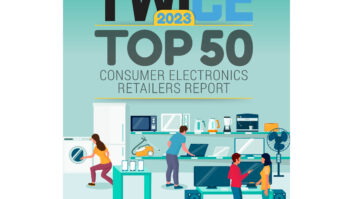It’s been nearly two decades since the earliest CE e-commerce pioneers placed their first tentative tech products online for sale (we’re talking about you Abt Electronics, Huppin’s/OneCall, Amazon, Vann’s and the late Circuit City).
Over the ensuing years, the industry has seesawed from outright bans of authorized goods on transactional websites, to a promotional wild West shoot-’em-up, to a tamer, more rational embrace of what has become an accepted — and expected — way for consumers to shop.
In the process, fears of an online-only future receded as brick-and-mortar chains learned to stop worrying and love the Internet. Sure, it hasn’t been pretty: The retailscape is littered with the carcasses of CE retail businesses that delayed or disregarded the transition to digital, and everyone still lives in the shadow of a seemingly unstoppable Amazon.com (which retained its No. 1 standing on the Top 25 CE E-tailers Report with $30 billion in sales).

Nonetheless, the e-tail rankings are a testament to the resiliency of tech merchants, who have learned to integrate online and in-store operations, adapt to further permutations like the move to mobile shopping, and even leverage Amazon’s dominance by becoming successful third-party sellers.
Indeed, only a handful of the Top 25 are what was once referred to as “pure-play” e-tailers (Amazon, Newegg, Groupon, Beach Trading and Rakuten). But even that line is blurring given the online success of single-showroom businesses like New York’s B&H Photo (No. 12) and Adorama (No. 20), and as Amazon, through its acquisition of Whole Foods and growing collection of book- and convenience stores, straddles both sides of the aisle.
Then there’s the original direct-sellers: the catalog houses (Crutchfield), the manufacturers (Dell, HP, Lenovo) and the broadcast retailers (QVC and HSN) for which e-tail either was, or should have been, a natural progression.
But it’s the multichannel merchants, led by second-, third- and fourth-place Best Buy, Apple Stores and Walmart, that are the mainstays of the Top 25 and have secured physical retail’s place in consumer tech’s future.
It wasn’t easy. Best Buy had already been written off as the next Circuit City-style casualty before a Frenchman from the hospitality industry swooped in and got its digital house in order. With CEO Hubert Joly’s efforts making up for lost time, sales at BestBuy.com grew a chart-topping 21 percent last year, to $5.2 billion, boosting the company’s online sales mix 2 percentage points to 16 percent of total U.S. revenue.
Find all Top Retail Report coverage in the TWICE Research Center.
The performance, along with a nearly matching showing by Costco.com (No. 7, with a billion dollars in CE sales), may have blunted Amazon and contributed to its relatively modest 4 percent gain last year.
Apple, of course, is a unique animal that’s fed by an almost cult-like obsession with its sleek but pricy iProducts, giving it one of the highest sales-per-square foot metrics in all of physical retail, and the biggest mix of online sales — 35 percent — of any Top 25 chain.
For Walmart, which wielded $3.8 billion in online sell-through last year, the game plan is still evolving under recently installed e-commerce chief Marc Lore, who’s only beginning to bring his digital chops and entrepreneurial spirit to the fore.
All told, our Top 25 e-tailers, as culled by TWICE market research partner Senex, garnered a cumulative $56.2 billion in online tech sales last year, a 6.8 percent increase that was dampened by double-digit declines at Staples (down 14 percent, dropping it six slots to 22 place) and 24-ranked HSN (down 10 percent, as it came under QVC’s umbrella).
See: Half Of Online Shoppers Shop At Amazon
Still, online sales growth more than doubled the pace of total CE retail sales (up 3.3 percent on TWICE’s Top 100 CE Retailers Report), and the 44 percent of revenue it commands on the Top 25 is more than quadruple what e-tail represents to retail at large.
Meaning? The marriage between consumer tech and e-commerce, first forged on the most basic of web pages back in the ’90s — long before donuts and diapers and next-day delivery — is fruitful and multiplying, and any dealer worth his or her salt had better get with the program.













